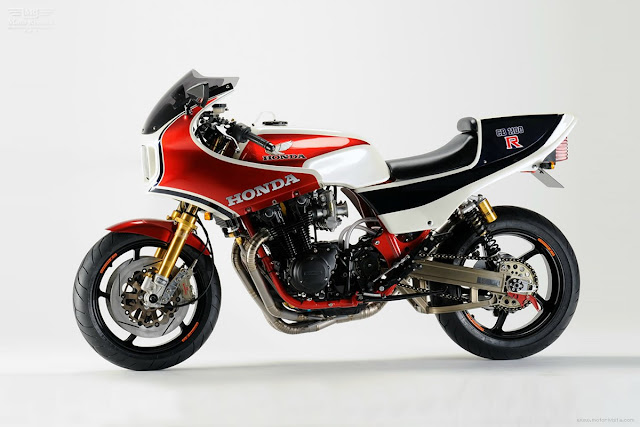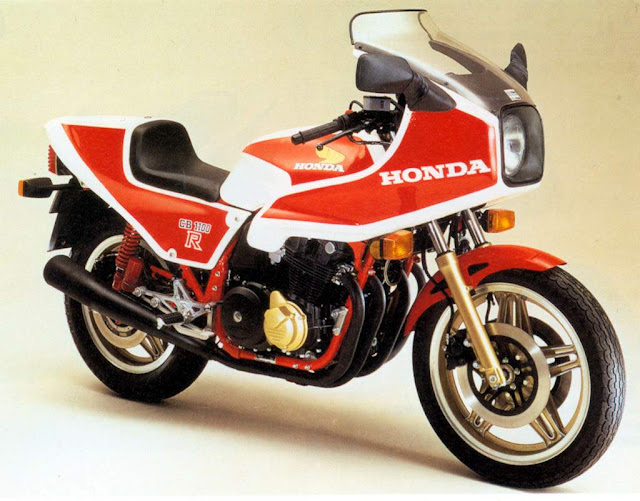Honda CB1100R
The original 1981- model CB1100R had a half- fairing plus other features designed for long-distance production racing, including a large-capacity fuel tank and single seat. Other key elements were its twin-piston front brake calipers, remote-reservoir rear shocks, and the tuned and strengthened 1062cc four-cylinder engine with its unmatched I15bhp power output.
The incomparable CB1100R provided proof that when mighty Honda set out to build the fastest production motorcycle in the world, the opposition didn't stand much chance. Especially when the bike in question was a purpose-built racer designed wdth little regard to cost, produced in very small numbers, and which competed against mass-produced machines that sold for half its price.
Honda’s aim in creating the CB1100R was victory in high-profile long-distance production races in Australia (especially the prestigious Castrol Six Hour) and South Africa. Regulations for these races were strict, with very few modifications allowed. So Honda created its first “homologation special’ by treating its current top model, the naked CB900FZ, to a spectacular makeover.
The result was a stunning superbike that was head and shoulders above all opposition in 1981.
Its racetrack dominance was predictable and sometimes dull. But for the fortunate few w'ho got to ride an 1100R, there was nothing remotely boring about a bike that rocketed to over 140mph (225km/h), handled and braked better than any bigfour-cylinder rival, and was even refined and comfortable too.
Honda's first requirement was more power. The CB900’s air-cooled, 16-valve four-cylinder motor was bored out to increase its capacity from 901 to 1062cc, and its compression ratio raised from 8.8 to 10:1. That lifted peak output by more than 20 per cent, to 115bhp at 9000rpm. Equally importantly, the motor was strengthened with modifications including new conrods, wider primary chain and redesigned crankcases.
Chassis layout remained conventional, but the 1100R benefited from a more rigid tw in-downtube steel frame, plus the most sophisticated cycle parts yet seen on a production motorcycle. Front forks had thick 37mm legs and adjustable air pressure, while the shocks could be fine-tuned for compression and rebound damping, and had the novel feature of remote hydraulic reservoirs, to resist overheating. The front brake held another first, with its twin-piston calipers.
One thing that Honda didn't achieve w'as make the CB1100R particularly light: at 5181b (235kg) dry, it w'as slightly heavier the 900FZ despite much use of plastic and aluminium. The production racer certainly looked the part, though, with its half-fairing, large fuel tank (for maximum racing range), and racy single seat. Nobody was in the slightest doubt about why the 1100R had been created, especially when Honda announced that only 1000 units would be built, and that in some markets the bike would cost almost twice as much as the CB900FZ.
Nothing this purposeful had been produced by a Japanese manufacturer before, and the 1100R duly trounced all opposition on the track. This was particularly true in the shorter races of the British Streetbike series, where the handful of Hondas were in a race of their own at the head of the field. The southern hemisphere long-distance events threw up more variables, but the CB1100R took plenty of wins.
Sensational road bike
Perhaps most impressively of all. the CBl 100R made a sensational road bike. Its phenomenal top- end power was matched not only by storming mid- range acceleration, but also by impressive smoothness and low-rev refinement. The protective fairing allowed more of that performance to be used. And although the 1100R was prone to a slight weave at very high speed, its chassis gave superb suspension control, fierce braking and generous ground clearance.
Honda made the bike even better in the next couple of years. In 1982 came the CB 1100R-C, with a full fairing (which cured the instability), dual seat, improved front forks and wider wheels.
A year later, the 1100R-D added damping- adjustable forks and an aluminium swingarm. The specification had changed, but one thing had not: the CBl 100R was still the fastest production motorcycle in the world.
As well as being an almost invincible production racer, the CB1100R made a superb roadster. This is the later fully-faired model, pictured on the Isle of Manduring TT week. If there had been a Production TT race in the early 1980s, the CBl 100R would doubtless have won that too.
Specification Honda CB1100R (1981)
- Engine Air-cooled dohc 16-valve four
- Capacity 1062cc (70 x 69mm)
- Maximum power 115bhp @ 9000rpm
- Transmission Five-speed, chain final drive
- Frame Steel twin downtube
- Suspension Telescopic front; twin shocks rear
- Brakes Twin discs front; disc rear
- Weight 5181b (235kg)
- Top speed 142mph (229km/h)























0 comments: